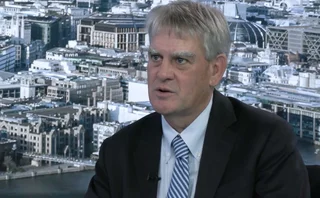
Derivatives house of the year: JP Morgan
Risk Awards 2022: Big bet on AI is delivering results

The popular image of JP Morgan – carefully cultivated by the bank itself – is that of a fortress capable of withstanding anything the financial markets can throw at it.
That image has some flaws. Fortresses exist to defend the status quo, they are enemies of change. JP Morgan, in contrast, is feverishly remodelling itself for a future that only exists in outline – the giant US bank is a kind of castle-and-laboratory, increasingly home to the kinds of people that are transforming modern life. Experimenting away within its walls are data scientists, engineers, developers and researchers, many of them pried from the ranks of Silicon Valley, academia and even the armed forces.
They include Manuela Veloso, the former head of the machine learning department at Carnegie Mellon University, and Drew Cukor, who previously led artificial intelligence projects for the US military. Eisar Lipkovitz joined last year from Lyft, where he ran the ride-sharing business, as did Gopal Kumarappan, a former top engineer at Adobe.
What draws many of them to JP Morgan is the bank’s big bet on artificial intelligence. “We have to make this an AI-first firm,” says David Hudson, co-head of digital and platform services for JP Morgan’s corporate and investment bank, echoing the view of chief executive Jamie Dimon.
From the top of the organisation to the bottom, the ‘AI first’ mantra rings loud and clear. Ashley Bacon, the bank’s chief risk officer, has a ready answer when asked if the bank’s embrace of AI is at odds with its reputation for prudent risk management. “It would probably be more of a risk if we didn’t have much interest in innovation and disruption,” he says.
Far from holding back the adoption of this technology, the risk department is leading the charge. “Some of our work is very data heavy and some of the significant machine learning developments from three, four years back came as a result of what we as a group needed to do,” Bacon says.
The bank is staking its future on this strategy. Its technology budget of $12 billion rivals the enterprise value of well-known digital natives, such as Lyft and Robinhood Markets. Some of the planned investment is being spent on what Hudson calls “AI enablement” – giving researchers and developers the tools and data they need to “experiment at scale”.
The transformation of JP Morgan into an ‘AI first’ bank is already well underway, but it has gone largely unnoticed, because it happened incrementally. The first step involved creating a vast digital library of all its data – everything from historical quotes and trades to legal contracts, customer records and even speeches, presentations and images. Then the machines began analyzing this data to extract patterns and anomalies. They passed their findings to humans at first, but soon began assuming routine tasks, such as blocking fraudulent transactions or sending marketing emails.
The technology is now widely used for all sorts of purposes. When the bank’s employees returned to the office in February, AI played a part in determining schedules and seating plans. Much of the bulk document analysis required for the Libor transition was handled by AI systems. The same technology is now being used to drive standardisation of contract language in other parts of the investment bank.
We have to make this an AI-first firm
David Hudson, JP Morgan
In equities, as much as 70% of the bank’s Euro Stoxx index options book – and 50% of the S&P 500 book – is priced using a machine learning program called Flow Trader. A more advanced version capable of handling exotics is currently in testing, and US single-stock options are also in the queue.
The credit business – historically a labyrinth of manual processes – is almost unrecognisable compared to even a year ago. Algorithms built using machine learning price 70% of all single-bond tickets below $2 million and similar systems are in development for other instruments.
And JP Morgan’s foreign exchange business has used machine learning techniques to sharpen the order placement skills of its execution algorithms.
These initiatives are starting to filter through to the bottom line. In the equities business, the bank has doubled its market share in US flow in the past two years, contributing to 22% growth in earnings, which topped $10 billion for the first time in 2021.
It all makes for a pretty unusual Risk Awards story, where the traditional focus has been on jumbo trades, structuring wizardry, and a dash of risk management grit – but these are run-the-bank accomplishments, at a time when change-the-bank has become the priority. In that race, JP Morgan has stolen a march on the competition. Its market-making and risk management capabilities are already being transformed.
Troy Rohrbaugh, head of global markets at JP Morgan, says the firm’s investments in AI are significant and will be what sets it apart in the future. “If you look at what we’re doing around analytics, automation and optimisation – particularly where we’re using machine learning and AI to systematically price high-volume franchise flow, it’s taking linear derivatives pricing to the next level,” he says. “The technology is doing some of the basics of what a good salesperson or trader does, but it’s doing it for thousands of clients constantly. That’s the differentiator.”
Risk first
While its many experiments are generating a buzz inside the bank, the fortress aspect of its character remains – it may aspire to be an AI-first bank; it continues to be a risk-first organisation. The bank posted a record profit of $48 billion 2021 – more than any of its peers. And it did so while avoiding the pitfalls that caused other banks to stumble even in relatively stable markets. It has not disclosed any dealings with Archegos Capital Management, the family office that defaulted on margin calls with at least five banks last March.
JP Morgan was involved in some of the year’s hottest market developments – cryptocurrencies and blank-check companies known as Spacs – but it was rarely at the centre of them. It didn’t need to be. In a toppy market, the bank rode the strength of its vaunted ‘flow machine’, which continued to pump liquidity to clients even during the year’s worst bouts of volatility.
Rohrbaugh says one of the main accomplishments for the markets business last year was being open for business at all times. “We were never in a position, from a risk management perspective, where we were unable to provide liquidity,” he says. “One of the most important things for us is to be there for clients on both the flow and non-flow sides through periods of extreme volatility.”
Even in its core businesses, the bank prospered by being conservative in its risk-taking. In lower volatility environments, where risk assets are rallying and banks have plenty of balance sheet capacity, pricing can become more and more competitive. “You get to a point where the price might be right for that moment, but if anything changes in terms of volatility or liquidity, it will be very hard to manage the residual risk,” says Rohrbaugh. The bank is disciplined about keeping its powder dry during such periods. “That’s very difficult in a year like 2021,” he says. “It’s one of the hardest decisions you need to make.”
One of the most important things for us is to be there for clients on both the flow and non-flow sides through periods of extreme volatility
Troy Rohrbaugh, JP Morgan
Part of the reason for this conservatism is a lingering hangover from the Covid-19 outbreak, which wreaked havoc with many risk and trading models. When the pandemic hit, most models predicted the worst, only to reverse course when governments and central banks stepped in with massive stimulus packages. Some of those actions have changed market and consumer behaviours in ways that may not be sustainable.
“The problem, of course, is still with us,” says Bacon. “You still can’t really calibrate certain models that consume macro-economic variables very well using data from this period.”
The bank has relied to some extent on expert judgement to weed out the data that may have explanatory power in the future from the mountain of anomalies, such as credit losses falling after unemployment spikes. At the same time, many of the problems that stymied markets at the height of the pandemic – the evaporation of liquidity in the US Treasury and commercial paper markets – remain largely unaddressed. “It didn’t turn into a prolonged problem because the government was so present in supporting small businesses, consumers and market liquidity in various different ways,” says Bacon.
The market may not be so fortunate next time. “From a risk management perspective, when you consider adverse scenarios in the future, there could be less capacity left for government support,” says Bacon. “You have to worry that things may play out differently if we get another shock.”
This is one of the many problems the bank is betting that AI can solve.
Platform building
JP Morgan’s shift to AI is part of a fundamental rethinking of its operating model. Arguably its biggest competitive advantage is its scale – it is the world’s largest bank by market cap, and the largest outside China by assets. But size can also have its drawbacks. The larger and more complex an organisation grows, the harder it becomes to manage and run at scale. At some point, diseconomies of scale start to creep in. “If you are doing something new in equities, and you can translate that across to FX options, for example, that’s where scale helps you,” says Hudson.
Get it wrong, of course, and scale stops being your friend.
AI has the potential to make even the largest and most complex businesses infinitely more scalable, but it also requires a fundamental re-engineering of traditional operating models. While capital markets businesses are typically built around vertical specialisations, AI is horizontal in nature – it cuts across business lines and products. Information stored in different systems and locations must be consolidated into a single pool of data that can be used to train machine learning algorithms. Many AI systems are general purpose and can be applied to solve a wide range of problems, which is easier to do when a firm runs on common platforms. To reap the full benefits of AI, JP Morgan had to break down its legacy silos and get its business lines working together.
The bank took its first big step towards this goal in September 2018 when it combined the technology, operations, data and AI teams from various business lines in the corporate and investment bank (CIB) into a new unit called digital and platform services. The 40,000-employee group is led by Hudson, who previously ran markets execution, and Guy Halamish, the former chief financial officer for global markets.
“The idea with digital and platform services was to take all the things that power innovation at the firm and bring them together for CIB clients,” says Hudson, “because ultimately you want innovation at scale to deliver real-world benefits.”
To date, the emphasis has been on creating horizontal platforms.

A prime example is the rollout of Athena, the bank’s Python-based risk and trading system, across the markets franchise. That effort is almost complete. Athena, which was originally developed for foreign exchange, is now used by the bank’s fixed income, credit and commodities business and is in the process of being implemented for equities.
The bank has also created an entirely new platform called OmniAI – a product of JP Morgan’s bank-wide global technology team – to provide researchers and developers with the tools and data they need to create and train machine learning algorithms. Work on OmniAI began in 2019, but some of the major breakthroughs have come in the past couple of years.
The first of these was the deployment of a data management platform called Jade – developed by the enterprise data technology team within the global technology group – which makes vast amounts of information from across the firm accessible via the public cloud.
Then came the creation of Data-X, a CIB-specific system developed by the digital and platform services team, which tracks and maintains a record of data as it moves around the firm. Hudson calls this “the biggest success” of 2021. Anytime data is sent or received within the firm, it is logged and conforms to a well-understood data model. “It instantly builds an audit trail of who’s using the data, where they got it, what they’re doing with it. You can pick up some data and know exactly what it is – is it a trade or a model output – and where it came from. If it’s wrong, you know who you go to to fix it,” says Hudson. “The AI people who want access to data can just use it. They don’t have to go and ask, they just need to be permissioned to use that class of data and register that they’re consuming it.”
The firm-wide AI platforms are overseen by Cukor, the retired US marine colonel who joined JP Morgan’s global technology team last year as head of AI transformation and engagement.
Last August, the bank also brought in Gopal Kumarappan from Adobe, where he was the head of engineering for document cloud services, to lead its new wholesale documentation management services group – part of Hudson and Halamish’s team within the CIB. The docs unit is tasked with improving the way the firm captures, classifies and indexes all types of documents in digital form for use with AI.
“The hard bit to all of this is the data,” says Hudson. “The big shift over the past year has been that we’ve standardised and organised the data so it’s more useful and transferable. When you get that right, and you have a trusted zone in the cloud, then you have created an environment where people can experiment using the most modern tools.”
That heavy lifting is now well advanced, Hudson says: “Most of our trading activities are now risk-managed with Athena – and we often run the same data models, where relevant, on OmniAI, with seamless integration between the two platforms. That’s a typical example of how we will get scale and efficiency in how we operate.”
AI in action
The meme stock frenzy in early 2021 set off alarm bells inside JP Morgan’s risk department. Retail traders on social media were taking investing to a new extreme, driving up the stocks of ailing companies to astronomical levels in the hope of squeezing short sellers. Options pricing models were pushed to their limits. Dealers quickly realised they had to find new ways to monitor activity on social media, including the sentiment and frequency of stock market-related posts.
“We need to recognise that we can get traumatic squeezes because there’s a segment of retail that is encouraged to buy the more expensive something gets, when you might expect institutional investors to do the opposite and at times even get themselves short,” says Bacon. “There’s an asymmetry to the upside that you need to factor into the way you think about risk and limits.”
Quantifying this is a difficult thing to do. “I don’t think it is very easy to model it,” says Bacon.
As it turns out, there’s an AI for that.
Sameena Shah, a managing director in JP Morgan’s AI Research group, developed a tool that converts the torrent of social media chatter around specific companies into a real-time sentiment score, expressed as a number between minus one and one. The quantiative research team in equities took that further, using the sentiment scores to create signals that traders can use to manage thier risk.
A version of the social media sentiment indicator was also made available to clients last September as part of a new research series called ‘Through the Retail Lens’.
The speed with which the tool was created and put into production demonstrates how well-oiled JP Morgan’s AI production has become. Staff in the bank’s artifical intelligence research labs, led by Veloso, can use OmniAI to obtain the data they need and then share the results of their experiments with relevant business lines. The Applied Commercial Intelligence Council, a cross-functional panel of senior executives co-led by Jason Sippel – the bank’s global head of equities – has been charged with accelerating the deployment of new AI and ML techniques for specific uses within the CIB.
We need to recognise that we can get traumatic squeezes because there’s a segment of retail that is encouraged to buy the more expensive something gets
Ashley Bacon, JP Morgan
AI development is not confined to JP Morgan’s research labs. There are skunk works teams – groups of data scientists, engineers and bankers – pursuing their own projects in almost every business line. The firm encourages this.
Many of the CIB’s computer scientists and engineers “are entrepreneurial,” says Hudson. “They’ll go and build all kinds of amazing things, but ultimately those ideas need to live in a business. They have to be entrepreneurial, have a problem to solve. You can’t just say, ‘go and make AI better for the firm’ without a specific desired outcome.”
Hans Buehler, JP Morgan’s head of equities and securities services quantitative research – and Risk.net’s quant of the year – leads an initiative called AAO that cuts across the markets business. The acronym stands for analytics, automation and optimisation – the three main areas where the firm believes AI and ML can make a difference in the near term.
The first of these areas is about extracting useful analysis and insights – such as social media sentiment – from large data sets. The second focuses on automating various decision-making processes. Flow Trader is one example of AI-driven automation, though there are many others across the firm.
The final piece – optimisation – is about identifying the optimal response to complex, multi-faceted problems, for which there are many possible combinations of answers. Hudson points to repo substitution as an example. “We collected and analysed all the data about our securities across the firm. Now, we can do better substitution for repos, because we have better insights into our data.”
Senior executives at the bank take great pains to point out that AAO – and the AI-first ethos generally – does not mean everything can be done by machine. There will always be humans in the loop, they say, not only in developing AI systems, but continually refining them through feedback and supervising their actions. Amazon is often cited within the firm as a model for an AI first company – the tech giant still employs over a million people.
Unsolved problems
The true promise of AI lies in its potential to solve problems that have eluded even the finest human minds. “This is now about funky problems that are unsolved, but if they were solved, it would be of enormous benefit to the firm and the industry,” says Hudson.
JP Morgan’s research labs are currently working on a number of projects – around multi-agent simulation, synthetic data, data discovery and encryption methods – that have the capacity to unlock new ways of trading and managing risk.
Multi-agent simulation and synthetic data could be the solution to an age-old problem in derivatives trading and risk management – models that are wedded to how the world acted during past events, such as the Covid-19 outbreak or the global financial crisis. Multi-agent simulations promise to reveal what would happen if market actors made different decisions in the future – for instance, if governments and central banks lacked the firepower to backstop markets in a future financial crisis, or if algorithmic traders suddenly pulled their liquidity.
“With multi-agent simulation, we can build a model that replicates the market and then tell some of the actors to start behaving differently, based on new information. How would the market react then? It means we can actually experiment without trading in the market,” says Hudson. “If we get this right, then it’s going to be transformational in how we manage risk.”
Other AI projects could fundamentally change how markets work and redefine the role of intermediaries. The bank is working on encryption methods that might one day allow clients to anonymously and securely share information with counterparties. Today, the buy- and sell-side engage in a poker game where each side tries to share just enough information to complete a transaction without revealing too much. Encryption technology could allow counterparties to freely share information and get more trades done without worrying about information leakage.
“This is about replacing the role of the trusted intermediary through technology,” says Hudson.
An even more ambitious project being led by the AI research lab aims to teach machines stochastic processes through reinforcement learning – a huge computational problem that grows more complex with each step.
Final frontier
One of the big challenges for any bank looking to harness AI is implementing it in a safe and compliant way. This is where JP Morgan’s risk department takes a strict line.
“You have to be rigorous about considering what it looks like if it goes wrong, from a financial, reputational, legal and compliance point of view,” says Bacon. “You have to size it, explain it and deploy it with risk limits, just as you would in managing anything else.”
The bank has gone to great lengths to ensure its risk managers have the technology skills and knowledge necessary to properly assess and oversee AI systems. Hundreds of risk managers have been trained in Python, not because they’re expected to code, but because they need to be able to dig into the inner workings of AI systems and push developers to address any potential risk issues.
“The skillset of the risk manager of the future needs to be tilted much more towards being tech and big data conversant,” says Bacon.
By its nature, machine learning poses different problems to static models. Algorithms that can recalibrate themselves might suddenly start behaving in unpredictable ways. Risk managers at JP Morgan pay particular attention to the calibration routines of self-learning algorithms.
Then, there’s the issue of explainability. The bank created its Explainable AI Center of Excellence, led by Daniele Magazzeni, a former co-director of the UK Center for Doctoral Training in Safe and Trusted AI, to develop techniques for explaining the decisions made by AI systems. There have been breakthroughs, such as the concept of actionable explanations, which ensure decisions are not grounded in factors that customers cannot control. But explainability remains a work in progress, with most new AI systems still assessed on a case-by-case basis.
The bank’s general policy is that AI models need to be explainable before they are put into production, but there is a sliding scale.
“Generally, explainability in AI matters greatly but less so in some areas such as fraud – as long as it works, there are fewer conceivable concerns about how decisions are driven,” says Bacon. “On the other hand, downsizing a credit line is a prime example of where you wouldn’t want to use an algorithm before you were very comfortable with its explainability and stability.”
Trading algorithms sit somewhere in the middle of this sliding scale. “Trading model risk can additionally be managed through size constraints, for example. You could potentially allow a model to trade dollar/yen in no more than $5 million if you had a more limited understanding of explainability,” says Bacon. “Deploying these approaches in a pilot format in a small size allows you to learn in parallel with building increasingly good controls and explainability around it over the long term.”
As the bank learns from experience, and barriers to adoption such as explainability fall away, its progress towards becoming an AI-first bank is only likely to accelerate.
Only users who have a paid subscription or are part of a corporate subscription are able to print or copy content.
To access these options, along with all other subscription benefits, please contact info@risk.net or view our subscription options here: http://subscriptions.risk.net/subscribe
You are currently unable to print this content. Please contact info@risk.net to find out more.
You are currently unable to copy this content. Please contact info@risk.net to find out more.
Copyright Infopro Digital Limited. All rights reserved.
As outlined in our terms and conditions, https://www.infopro-digital.com/terms-and-conditions/subscriptions/ (point 2.4), printing is limited to a single copy.
If you would like to purchase additional rights please email info@risk.net
Copyright Infopro Digital Limited. All rights reserved.
You may share this content using our article tools. As outlined in our terms and conditions, https://www.infopro-digital.com/terms-and-conditions/subscriptions/ (clause 2.4), an Authorised User may only make one copy of the materials for their own personal use. You must also comply with the restrictions in clause 2.5.
If you would like to purchase additional rights please email info@risk.net
More on Awards
Collateral management and optimisation product of the year: CloudMargin
Delivering the modern blueprint for enterprise collateral resilience
Flow market-maker of the year: Citadel Securities
Risk Awards 2026: No financing; no long-dated swaps? “No distractions,” says Esposito
Pricing and analytics: fixed income – Quantifi
Quantifi delivers high-performance, transparent and adaptable pricing and risk analytics for fixed income and credit markets
Derivatives house of the year: Citi
Risk Awards 2026: Rev up, RWAs down, as US bank gets back on track (with added XiNG and XiP)
Technology vendor of the year: SS&C Algorithmics
Risk Awards 2026: From cloud, to chips, to maths tricks – vendor getting more out of existing tech
SS&C Algorithmics: winner’s interview with Curt Burmeister
SS&C Algorithmics wins three categories in this year’s Markets Technology Awards in addition to Technology vendor of the year at the Risk Awards
Best vendor for system support and implementation: Murex
Murex wins Best vendor for system support and implementation at the Markets Technology Awards 2026
Pricing and analytics: cross-asset and structured – Murex
Murex wins Pricing and analytics: cross-asset and structured at the Markets Technology Awards 2026 thanks to its MX.3 platform







